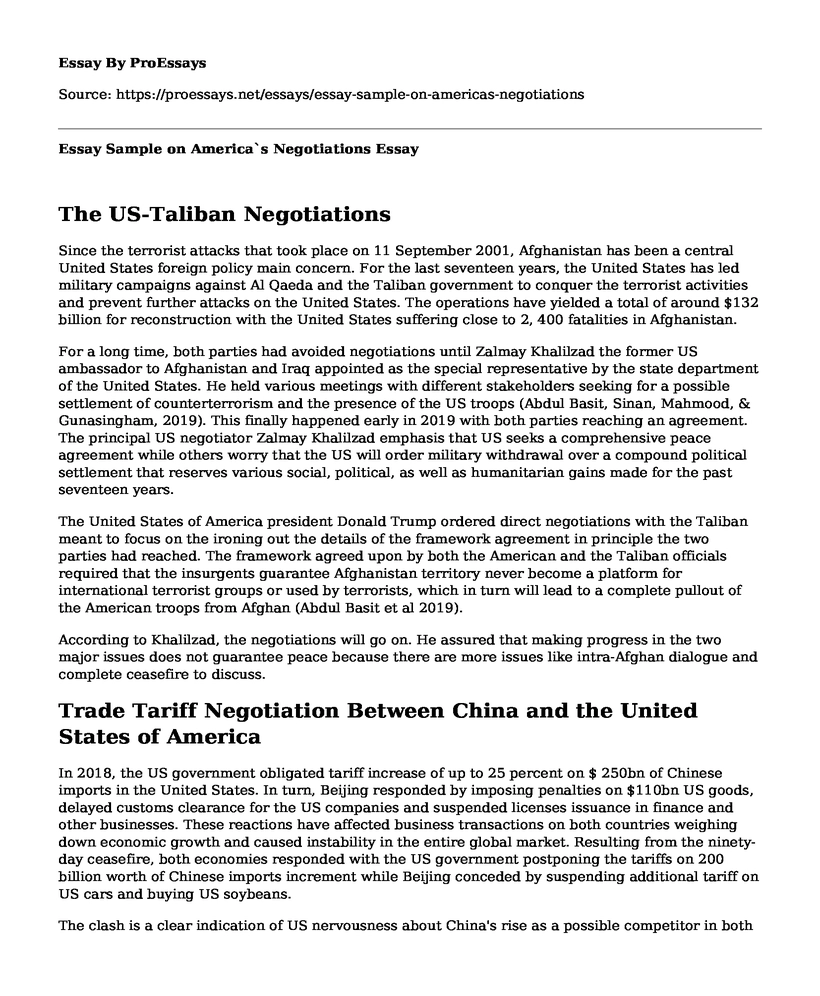The US-Taliban Negotiations
Since the terrorist attacks that took place on 11 September 2001, Afghanistan has been a central United States foreign policy main concern. For the last seventeen years, the United States has led military campaigns against Al Qaeda and the Taliban government to conquer the terrorist activities and prevent further attacks on the United States. The operations have yielded a total of around $132 billion for reconstruction with the United States suffering close to 2, 400 fatalities in Afghanistan.
For a long time, both parties had avoided negotiations until Zalmay Khalilzad the former US ambassador to Afghanistan and Iraq appointed as the special representative by the state department of the United States. He held various meetings with different stakeholders seeking for a possible settlement of counterterrorism and the presence of the US troops (Abdul Basit, Sinan, Mahmood, & Gunasingham, 2019). This finally happened early in 2019 with both parties reaching an agreement. The principal US negotiator Zalmay Khalilzad emphasis that US seeks a comprehensive peace agreement while others worry that the US will order military withdrawal over a compound political settlement that reserves various social, political, as well as humanitarian gains made for the past seventeen years.
The United States of America president Donald Trump ordered direct negotiations with the Taliban meant to focus on the ironing out the details of the framework agreement in principle the two parties had reached. The framework agreed upon by both the American and the Taliban officials required that the insurgents guarantee Afghanistan territory never become a platform for international terrorist groups or used by terrorists, which in turn will lead to a complete pullout of the American troops from Afghan (Abdul Basit et al 2019).
According to Khalilzad, the negotiations will go on. He assured that making progress in the two major issues does not guarantee peace because there are more issues like intra-Afghan dialogue and complete ceasefire to discuss.
Trade Tariff Negotiation Between China and the United States of America
In 2018, the US government obligated tariff increase of up to 25 percent on $ 250bn of Chinese imports in the United States. In turn, Beijing responded by imposing penalties on $110bn US goods, delayed customs clearance for the US companies and suspended licenses issuance in finance and other businesses. These reactions have affected business transactions on both countries weighing down economic growth and caused instability in the entire global market. Resulting from the ninety-day ceasefire, both economies responded with the US government postponing the tariffs on 200 billion worth of Chinese imports increment while Beijing conceded by suspending additional tariff on US cars and buying US soybeans.
The clash is a clear indication of US nervousness about China's rise as a possible competitor in both telecommunication and other forms of technology. Chinese leader's emphasis on the country's probability as an export market in a bid to defuse complains. Following this, the Chinese government has proclaimed a sequence of regulatory changes over the past year. Some of the Chinese officials claim that technology enterprises might open to foreign markets through companies but they have given no specific details to this. It is, therefore, uncertain if this will content United States (Eckhardt, 2019). On 1 December 2018, the two presidents met at private dinner in Argentina and agreed to begin negotiations on structural changes about IP and technological issues. Negotiations about this are still going on with the trade war continuing between the two nations with a goal to achieve an agreement by 1 March 2019.
References
Abdul Basit, I. B., Sinan, S. M., Mahmood, S., & Gunasingham, A. (2019). SOUTH ASIA: Afghanistan, Bangladesh, India, Pakistan, Sri Lanka. Counter Terrorist Trends and Analyses, 11(1), 33-64. Retrieved from www.jstor.org/stable/26568578
Eckhardt, J. (2019). Law and Diplomacy in EU-China Trade Relations, A Historical Overview. EU-Asia Trade Dispute Management, 1-25. Retrieved from file:///C:/Users/chrisjanice-pc/Downloads/Eckhardt2019_EU-Chinatraderelations.pdf
Cite this page
Essay Sample on America`s Negotiations. (2022, Dec 01). Retrieved from https://proessays.net/essays/essay-sample-on-americas-negotiations
If you are the original author of this essay and no longer wish to have it published on the ProEssays website, please click below to request its removal:
- Argumentative Essay on Eating Factory Farmed Meat
- Rape and Rape Culture Pervasiveness
- Domestic Violence Courts Essay Example
- Protesting for Rights and Property: Gregory Lee Johnson's 1984 - Essay Sample
- Essay Example on Unequal Opportunities & Denied Dignity: Minority Groups in the US
- Essay Example on COVID-19 Impact: US vs. Canada - Uncompared Statistics and Unequal Outcomes
- Free Essay: Understanding and Addressing Racism-Related Stress for Healing and Unity







